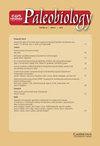对胚胎化石的解释需要对发育年龄进行合理的评估
IF 2.6
2区 地球科学
Q2 BIODIVERSITY CONSERVATION
引用次数: 0
摘要
摘要恐龙胚胎在科学文献中引起了很多兴奋,并且由于公众对恐龙生物学的兴趣而经常被广泛报道。保存完好、关节清晰的窃蛋龙胚胎通常被认为是接近孵化的发育阶段,因为它们的体积很大,骨骼骨化程度也很好。基于这一证据,最近的一份报告表明,一个胚胎的头部位置让人想起了鸟类的孵化位置。在这里,我们将探讨如何估计保存完好的窃蛋龙胚胎的发育阶段,而不是假设。这将有助于我们理解它们的发育生物学及其进化后果。通过定量方法和与现代鳄鱼胚胎的比较,我们发现所有关节的蛋龙胚胎相对于卵来说都很小,很可能处于相当于发育时期的50%-60%左右的发育阶段,也就是说,甚至还没有接近孵化。这一结论得到了以下事实的支持:鳄鱼骨骼的许多元素在孵化前数周就已经很好地骨化了,窃蛋龙胚胎的头部位置也与孵化前许多天的鳄鱼胚胎相当。对这些保存完好的窃蛋龙胚胎发育生物学阶段的误解阻碍了我们对其生殖生物学真实本质的理解。我们敦促对他们的解释采取更保守的态度。这一点很重要,因为一旦证据不足的观点在世界各地被报道出来,公众对恐龙生物学的误解就很难消除。本文章由计算机程序翻译,如有差异,请以英文原文为准。
Interpretation of fossil embryos requires reasonable assessment of developmental age
Abstract. Dinosaur embryos cause a lot of excitement in the scientific literature and are often widely reported because of the general public's interest in dinosaur biology. Well-preserved, articulated oviraptorosaur embryos in eggs are usually interpreted as representing a stage of development close to hatching because of their large size and good level of skeletal ossification. Based on this evidence, a recent report suggested that the position of the one embryo's head was reminiscent of an avian-like hatching position. Here we explore how the developmental stage of well-preserved oviraptorosaur embryos can be estimated, rather than assumed. This will help in our understanding of their developmental biology and its evolutionary consequences. Using quantitative methods and comparison with modern crocodilian embryos, we show that all articulated oviraptorosaur embryos are small relative to the egg and most likely at a stage of development equivalent to around 50%–60% of the developmental period, that is, not even close to hatching. This conclusion is supported by the fact that many elements of the crocodilian skeleton are well ossified many weeks before hatching and the position of oviraptorosaur embryos' heads was also comparable to a crocodilian embryo many days before hatching. Misunderstandings about the stage of the developmental biology of these well-preserved oviraptorosaur embryos hampers our understanding of the true nature of their reproductive biology. We urge a more conservative approach to their interpretation. This is important, because misunderstandings in the minds of the public about dinosaur biology are hard to counter once poorly evidenced ideas have been reported around the world.
求助全文
通过发布文献求助,成功后即可免费获取论文全文。
去求助
来源期刊

Paleobiology
地学-古生物学
CiteScore
5.30
自引率
3.70%
发文量
38
审稿时长
>12 weeks
期刊介绍:
Paleobiology publishes original contributions of any length (but normally 10-50 manuscript pages) dealing with any aspect of biological paleontology. Emphasis is placed on biological or paleobiological processes and patterns, including macroevolution, extinction, diversification, speciation, functional morphology, bio-geography, phylogeny, paleoecology, molecular paleontology, taphonomy, natural selection and patterns of variation, abundance, and distribution in space and time, among others. Taxonomic papers are welcome if they have significant and broad applications. Papers concerning research on recent organisms and systems are appropriate if they are of particular interest to paleontologists. Papers should typically interest readers from more than one specialty. Proposals for symposium volumes should be discussed in advance with the editors.
 求助内容:
求助内容: 应助结果提醒方式:
应助结果提醒方式:


